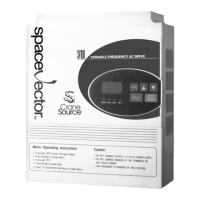43
When establishing the motor parameters, assure the motor rated current does not
exceed the drive current rating. The default values for the Advanced Level functions
number 20, 21, and 22 may be set to values more closely representing the motor being
used with the drive. This is accomplished as follows:
1. Determine the motor synchronous speed and full load speed in revolutions
per minute.
2. Calculate the rated motor slip in Hertz using the following equations.
Rated Motor Slip (rpm) = [motor sync speed (rpm) – motor rated speed (rpm)]
Rated Motor Slip (Hertz) =
3. Set Advanced Level function number 20 to the rated motor slip value
calculated in Hertz in step 2.
4. Obtain the motor rated current in amperes from the motor nameplate.
5. Obtain the drive current rating in amperes.
6. If the motor rated current obtained in step 4 is greater than the drive current
rating obtained in step 5, use a larger drive having a current rating equal to
or greater than that of the motor.
7. If the motor rated current obtained in step 4 is less than the drive current
rating obtained in step 5, set Advanced Level function number 21 to the
motor rated current obtained in step 4.
8. Calculate the minimum drive phase loss detection current.
Minimum Drive Current (Amperes) = 0.15 x [drive rated current (Amperes)]
9. Calculate the motor no load current.
Motor No Load Current (Amperes) = 0.30 x [motor rated current (Amperes)]
10.If the motor no load current calculated in step 9 is less than the minimum
drive phase loss detection current calculated in step 8, the drive cannot
detect phase loss and phase loss protection is no longer guaranteed. Con-
sult the factory.
Section 3.3: Establishing Motor Parameters
60 Hz. x [rated motor slip (rpm)]
motor sync speed (rpm)

